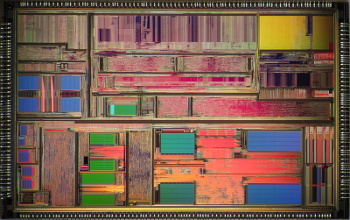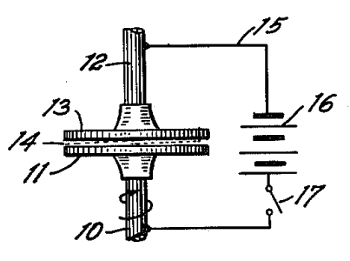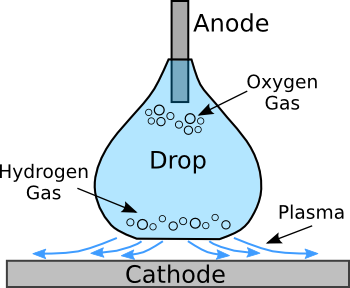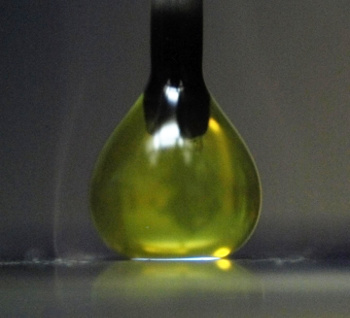Plasma Cushion
September 14, 2015
Love may make the world go 'round, but
electrons are what hold it together. Electrons
bond atoms together in
solids, and
matter is affected by
electrical forces in many ways. In my
graduate research, I was introduced to two unusual ways in which
electricity can modify
materials. These were
electrical discharge machining and
electromigration.
HfV
2 is an
intermetallic compound formed from
hafnium and
vanadium, and it's interesting because it's a
superconductor, and it absorbs
hydrogen.[1] It's also an extremely
hard material that can't be cut by a
hacksaw. The way that we prepared
specimens of HfV
2 for
measurement was to slice them in an
electrical discharge machine.
Electric current pulses between a
razor blade and our
alloy in a tank of
dielectric liquid made straight cuts at a rate of about a
millimeter/hour.
You need more than just smaller
transistors to make a smaller
integrated circuit. The transistors would be useless without the "wires" that link them together. The "wires" in this case are
planar deposits of a
conducting metal, and the metal used for these interconnects was originally pure
aluminum, since it's easy to
deposit. When the
cross-sectional area of a current-carrying wire becomes small, the
current density, which is the number of electrons moving though the area in a given time, becomes large.

There were a modest 4.3 million transistors on this chip in 1997. Advanced CPUs now have 5 billion.
Photo of an AMD K5 PR150 microprocessor die by Pauli Rautakorpi, via Wikimedia Commons.)
Small though they are, moving electrons have
momentum, and this flow of electrons tend to bump atoms out of place. This is especially true at
grain boundaries, and such movement of material can eventually become so large as to break the electrical connection. Electromigration was first observed about a hundred years ago, and it was discovered to be a problem in integrated circuits in the
mid-1960s.
At that time, the interconnects were a few
micrometers in dimension; now, they're a few tens of
nanometers in dimension, so current densities are up. The effect is mitigated through lower operating
voltages and lower currents; and using
copper, which is less susceptible to electromigration than aluminum. Also,
geometry is a factor, since the current density in a gentle conductor bend is less than that for a
right angle bend.
Although it's impossible to
model electromigration from
first principles, there's a
phenomenological model,
Black's equation, that allows
estimation of the mean-time-to-failure (
MTTF) of an integrated circuit arising from electromigration; viz.,

in which
A and
n are model
parameters,
j is the current density,
Q is an
activation energy,
k is the
Boltzmann constant, and
T is the
absolute temperature. This, of course, is a typical
Arrhenius law model so useful in many problems, with the values of
A,
n, and
Q determined from
experiment. Ideally,
n = 2. The model is important, since testing at elevated
temperature will predict performance at operating temperature.
Electric fields will affect solids suspended in
liquids by the
electrorheological effect in which small,
non-conducting particles in an
insulating fluid will align themselves with the electric field. The alignment arises from the
polarizability of the particles, and the polarized particles stick together like
magnets. I wrote about this effect in an
earlier article (Electrorheology, April 13, 2012)
The electrorheological effect was discovered by Willis M. Wlnslow, who
patented some applications in 1947, and
published a
paper in the
Journal of Applied Physics in 1949.[2-3] Winslow was able to attain a reversible shear resistance of several hundred grams per square centimeter. Unfortunately, electric field strengths of the order of a kilovolt per millimeter are required.

Figure 1 of US Patent No. 2,417,850, "Method and Means for Translating Electrical Impulses into Mechanical Force," Willis M. Winslow, March 25, 1947.
(Via Google Patents). [2]
A simple electrorheological material can be made from just cornstarch mixed with
vegetable oil. Since electrorheological materials are potentially useful for things such as automotive braking, there's still much ongoing
research. A mixture of
strontium titanyl oxalate in
silicone oil has been shown to give a yield stress of 200
kPa at an applied field of 5 kV/mm.[4]
The electrorheological effect gives us increased
friction, but there are ways in which an electric field will reduce friction. One method is to cause migration of a
lubricant to a surface. In one experiment, application of an electric field to an
acrylamide hydrogel swollen with the
ionic surfactant,
sodium dodecyl sulfate, caused the surfactant to migrate to one surface, thereby reducing the
friction coefficient by about 75%.[5] The effect is reversible, but the friction reduction is from an originally enhanced friction caused by the gel.
Scientists at
CEA-LETI (Grenoble, France), the
Ecole Polytechnique (Palaiseau, France), and the
University Grenoble Alpes (Grenoble, France) have just shown that application of somewhat more than 50 volts between a droplet of weak
hydrochloric acid and a metal plate causes the droplet to
levitate.
The mechanisms involved are the
electrolysis of water, creating
hydrogen gas and
steam at the liquid-metal interface, and excitation of this gas into a
plasma by the applied voltage.[6-7] Electrolysis proceeds, since the droplet is attached to the
anode of the electrical circuit, with the metal plate acting as the
cathode (see figure).

Schematic diagram of a plasma-levitated droplet.
The droplet is a dilute solution of hydrochloric acid. Electrolysis produces oxygen at the anode, and hydrogen at the cathode.
(Illustration by the author using Inkscape.)
This effect was found in
experiments designed to investigate a
phenomenon in
nuclear power plant steam generators called a "boiling crisis." In this phenomenon,
bubbles in water merge to form a
vapor layer on
heat-transfer surfaces, reducing the
thermal conductivity at the interface.[7] The team of
French scientists decided to study the phenomenon in an experiment using a easy way to generate gas at liquid-metal interface.
Their experiment was designed to produce electrolysis in droplets and to film their behavior at high speed. When a drop touched the metal plate and the applied
potential was somewhat above 50
volts,
sparks appeared at the bottom of the droplet, it levitated, and a faint blue
glow could be seen at the interface between the liquid and metal.[7]
It was first thought that the droplets were just resting on a layer of the generated hydrogen gas, but it was found that the interface was filled with
water vapor.[7] The hot water vapor indicated that the levitation was an example of the
Leidenfrost effect.[6-7] In the Leidenfrost effect, seen when water droplets dance on a hot
pan, a cushion of water vapor levitates a droplet above a hot surface.
It was concluded that the levitation was a
thermal phenomenon, caused by
heating of the metal surface. Stable levitation was only possible for thin cathode plates that didn't act as
heat sinks.[6] While 50 volts is a relatively low voltage, the gap between the liquid and metal is likewise small, so the electric field
gradient is large enough to generate a plasma.[7]

Plasma-levitated droplet.
The blue glow of the plasma below the dilute hydrochloric acid solution, generated at somewhat more than 50 volts, is clearly see.
(Photograph: Cedric Poulain, et al / CEA.)
Spectroscopy of the
emitted light indicates that some cathodic
sputtering occurs, since
spectral lines of the metal also appear.[6] Says Cedric Poulain, a
physicist at the
French Alternative Energies and Atomic Energy Commission, "This method is probably an easy and original way to make a plasma."[7] While the results are quite removed from the original motivation of studying thermal transfer in nuclear reactors, they show how
curiosity-driven research can yield interesting results.
References:
- P. Duffer, D.M. Gualtieri, and V.U.S. Rao, "Pronounced Isotope Effect in the Superconductivity of HfV2 Containing Hydrogen (Deuterium)," Phys. Rev. Lett., vol. 37, no. 21 (November 22, 1976), pp. 1410-1413.
- Willis M. Winslow, "Method and Means for Translating Electrical Impulses into Mechanical Force," US Patent No. 2,417,850, March 25, 1947.
- Willis M. Winslow, "Induced fibration of suspensions," Journal of Applied Physics, vol. 20, no. 12 (December 1, 1949), pp. 1137-1140.
- Carlos S. Orellana, Jinbo He and Heinrich M. Jaeger, "Electrorheological response of dense strontium titanyl oxalate suspensions," Soft Matter, 2011, vol. 7, no. 18 (2011), pp. 8023-8029.; PDF file available, here.
- Hiroshi Matsukawa, Summary of "Friction Control of a Gel by Electric Field in Ionic Surfactant Solution," J. Phys. Soc. Jpn. Online News and Comments, June 10, 2010.
- Cedric Poulain, Antoine Dugue, Antoine Durieux, Nader Sadeghi, and Jerome Duplat, "The plasma levitation of droplets," Applied Physics Letters, vol. 107, Document No. 064101 (August 11, 2015), http://dx.doi.org/10.1063/1.4926964. This is an Open Access publication with a PDF file available, here.
- Droplets levitate on a cushion of blue light, American Institute of Physics Press Release, August 11, 2015.
Permanent Link to this article
Linked Keywords: Love Makes the World Go 'Round; electron; chemical bond; atom; solid; matter; electricity; electrical; force; graduate school; research; material; electrical discharge machining; electromigration; intermetallic compound; hafnium; vanadium; superconductivity; superconductor; hydrogen; hardness; hard; hacksaw; sample; specimen; measurement; electrical discharge machine; electric current; pulse; razor blade; alloy; dielectric; liquid; millimeter; transistor; integrated circuit; plana; electrical conductor; conducting; metal; aluminum; physical vapor deposition; cross-sectional area; current density; central processing unit; CPU; transistor count; AMD K5 PR150 microprocessor; die; Pauli Rautakorpi; Wikimedia Commons; momentum; grain boundary; mid-1960s; micrometer; nanometer; voltage; copper; geometry; right angle; mathematical model; first principles; phenomenology; phenomenological; Black's equation; approximation; estimation; parameter; activation energy; Boltzmann constant; absolute temperature; Arrhenius equation; Arrhenius law; experiment; temperature; electric field; liquid; electrorheological effect; non-conducting; insulator; insulating; polarizability; magnet; patent; scientific literature; academic publishing; paper; Journal of Applied Physics; reversible process; shear stress; shear resistance; gram-force; square centimeter; kilovolt; millimeter; Google Patents; cornstarch; vegetable oil; automobile; automotive; brake; braking; research; strontium titanyl; oxalate; silicone oil; pascal; kPa; friction; lubricant; acrylamide; hydrogel; ionic surfactant; sodium dodecyl sulfate; coefficient of friction; friction coefficient; Scientist; CEA-LETI (Grenoble, France); Ecole Polytechnique (Palaiseau, France); University Grenoble Alpes (Grenoble, France); hydrochloric acid; levitation; levitate; electrolysis of water; hydrogen gas; steam; plasma; anode; cathode; schematic diagram; oxygen; Inkscape; experiment; phenomenon; nuclear power plant; steam generator; bubble; vapor; heat-transfer; thermal conductivity; France; French; potential; volt; electric spark; glow discharge; water vapor; Leidenfrost effect; pan; temperature; thermal; heat; heating; heat sink; gradient; Cedric Poulain; spectroscopy; gas-discharge lamp; sputtering; spectral line; physicist; French Alternative Energies and Atomic Energy Commission; blue skies research; curiosity-driven research; Willis M. Winslow, "Method and Means for Translating Electrical Impulses into Mechanical Force," US Patent No. 2,417,850, March 25, 1947.